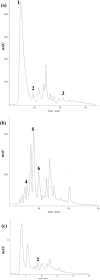Protective Effect of a Polyherbal Traditional Formula Consisting of Rosa damascena Mill., Glycyrrhiza glabra L. And Nardostachys jatamansi DC., Against Ethanol-induced Gastric Ulcer
- PMID: 28979324
- PMCID: PMC5603879
Protective Effect of a Polyherbal Traditional Formula Consisting of Rosa damascena Mill., Glycyrrhiza glabra L. And Nardostachys jatamansi DC., Against Ethanol-induced Gastric Ulcer
Abstract
"VARD" formula consisting of Rosa damascena Mill. (Rosaceae) petals, and rhizomes of Glycyrrhiza glabra L. (Papilionaceae) and Nardostachys jatamansi DC. (Valerianaceae), has been proposed for gastric ulcer in Iranian traditional medicine. We investigated the antiulcer activity of each plant separately and in combination. The biochemical and molecular functions of extracts were also evaluated. Each plant hydroalcoholic extract was standardized via determination of total phenolic and flavonoid contents, also via some phenolic compounds determination and specially glycyrrhizic acid in G. glabra by using HPLC. Rats received orally extracts of the plants (20, 40 and 80 mg/Kg) and "VARD" (45 mg/Kg) 1 h before ethanol administration. Two h after receiving ethanol, animals were sacrificed; the stomach was removed for macroscopic and microscopic assessment. Also heme-oxygenase-1, glutathione, and catalase were measured in the gastric tissue of the rats pretreated by "VARD" and dose of 20 mg/Kg of extracts. Among three extracts, R. damascena and G. glabra contained more total phenolic and flavonoid content respectively. Gallic acid was prominent compound in R. damascena. The extracts of R. damascena, G. glabra, and N. jatamansi significantly decreased ulcer index. ED50 values were 8.2, 31.86 and 25.08 mg/Kg respectively. "VARD" significantly decreased ulcer index compared to 20 mg/Kg of G. glabra (p < 0.0001) and N. jatamansi (p < 0.001). Pretreatment with "VARD" and each plant extracts (20 mg/Kg) increased glutathione, catalse and heme-oxygenase-1 significantly (p < 0.05) in comparison with control group. Our findings indicate that "VARD" partly via antioxidant activity can be considered as an effective antiulcer formula.
Keywords: Antioxidant; Glycyrrhiza glabra; Heme-oxygenase-1; Inflammation; Nardostachys jatamansi; Peptic ulcer; Rosa damascena.
Conflict of interest statement
The Authors declare that there are no conflicts of interest.
Figures







Similar articles
-
Preparation and Evaluation of Possible Antioxidant Activities of Rose Traditional Tablet"(Qurs-e-Vard)" A Selected Traditional Persian Medicine (TPM) Formulation via Various Procedures.Curr Drug Discov Technol. 2021;18(5):e28092020186381. doi: 10.2174/1570163817666200929114517. Curr Drug Discov Technol. 2021. PMID: 32990537
-
Antiulcer properties of Glycyrrhiza glabra L. extract on experimental models of gastric ulcer in mice.Iran J Pharm Res. 2015 Fall;14(4):1163-70. Iran J Pharm Res. 2015. PMID: 26664383 Free PMC article.
-
Evaluation of Antiulcer and Antioxidant Activity of Barleria gibsoniDalz. Leaves.Pharmacognosy Res. 2016 Oct-Dec;8(4):226-230. doi: 10.4103/0974-8490.188879. Pharmacognosy Res. 2016. PMID: 27695259 Free PMC article.
-
Nardostachys jatamansi (D.Don) DC.-Challenges and opportunities of harnessing the untapped medicinal plant from the Himalayas.J Ethnopharmacol. 2020 Jan 10;246:112211. doi: 10.1016/j.jep.2019.112211. Epub 2019 Sep 15. J Ethnopharmacol. 2020. PMID: 31533076 Review.
-
Rosa damascena as holy ancient herb with novel applications.J Tradit Complement Med. 2015 Oct 30;6(1):10-6. doi: 10.1016/j.jtcme.2015.09.005. eCollection 2016 Jan. J Tradit Complement Med. 2015. PMID: 26870673 Free PMC article. Review.
Cited by
-
The effects of rose oil on liver damage in an experimental model of obstructive jaundice.Ulus Travma Acil Cerrahi Derg. 2025 Jun;31(6):495-504. doi: 10.14744/tjtes.2025.96613. Ulus Travma Acil Cerrahi Derg. 2025. PMID: 40511765 Free PMC article.
-
Evaluation of Wound Healing Property of the Ethanolic Extract of Glycyrrhiza Glabra on Vero Cell Lines Using In Vitro Scratch Assay Test.J Pharm Bioallied Sci. 2023 Jul;15(Suppl 1):S630-S635. doi: 10.4103/jpbs.jpbs_61_23. Epub 2023 Jul 5. J Pharm Bioallied Sci. 2023. PMID: 37654411 Free PMC article.
-
Bioactive characterization of ultrasonicated ginger (Zingiber officinale) and licorice (Glycyrrhiza Glabra) freeze dried extracts.Ultrason Sonochem. 2022 Aug;88:106048. doi: 10.1016/j.ultsonch.2022.106048. Epub 2022 May 26. Ultrason Sonochem. 2022. PMID: 35724486 Free PMC article.
-
Phytochemistry and Biological Activity of Medicinal Plants in Wound Healing: An Overview of Current Research.Molecules. 2022 Jun 1;27(11):3566. doi: 10.3390/molecules27113566. Molecules. 2022. PMID: 35684503 Free PMC article. Review.
References
-
- Majumdar D, Atherton J. Peptic ulcers and their complications. Surgery. . 2006;24:110–4.
-
- Sung JJY, Kuipers EJ, Elserag HB. Systematic review: the global incidence and prevalence of peptic ulcer disease. Aliment. Pharmacol. Ther. . 2009;29:938–46. - PubMed
-
- Fauci A, Braunwald E, Kasper DL, et al. Peptic Ulcer Disease and Related Disorders In: Harrison’s Principles of Internal Medicine. 17th ed. New York : McGraw-Hill; 2008.
-
- Feldman M, Friedman LS, Brandt LJ. Sleisenger and Fordtran›s gastrointestinal and liver disease: pathophysiology, diagnosis, management. 9th ed. Philadelphia, USA: Elsevier Saunders; 2010. chapter 52.
LinkOut - more resources
Full Text Sources
